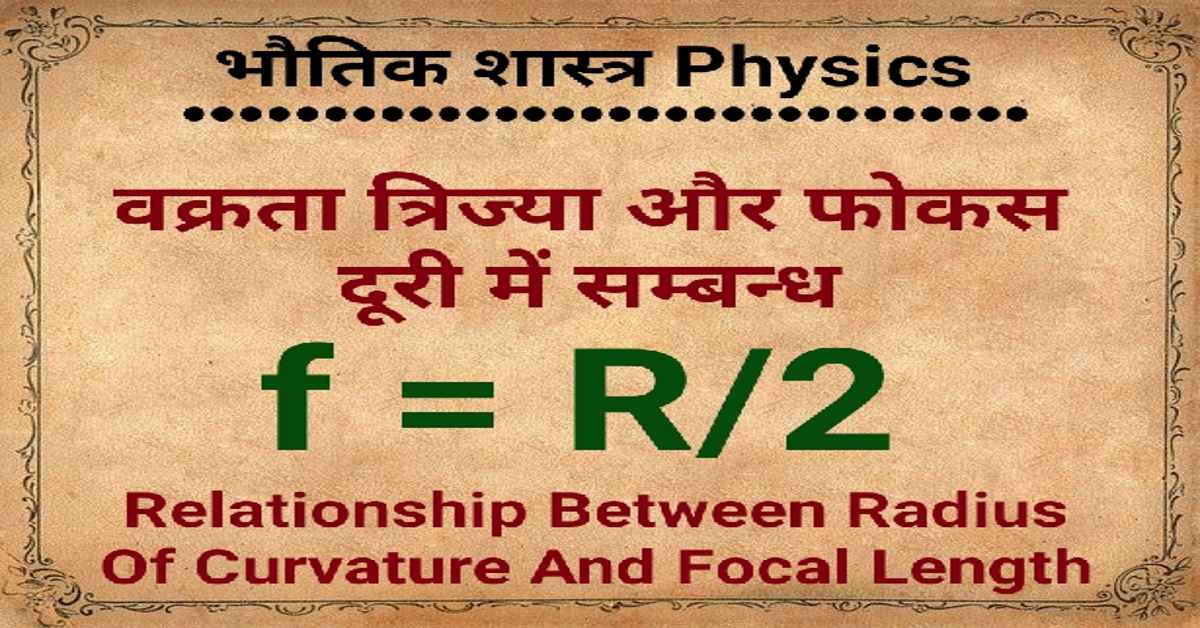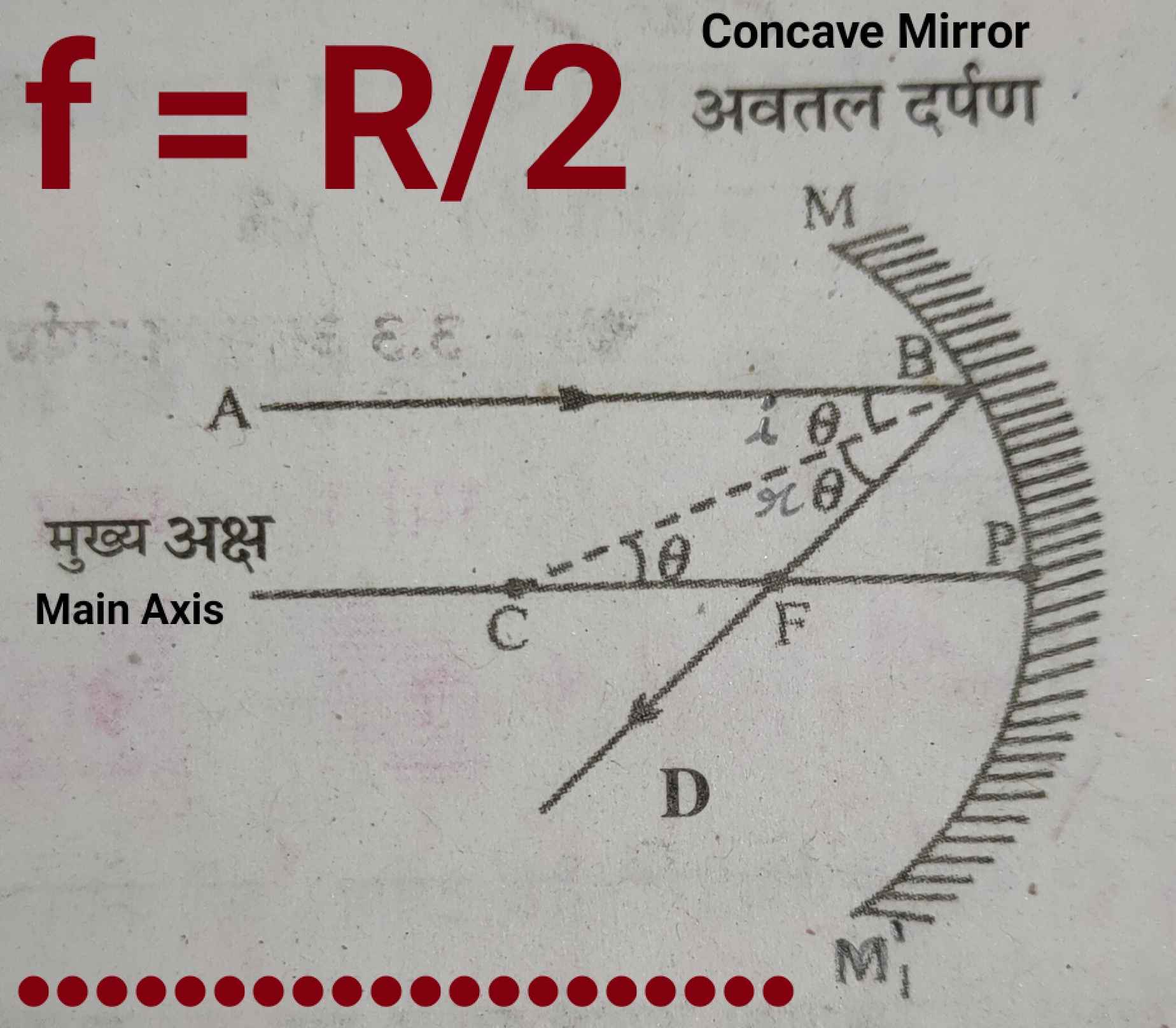
गोलीय दर्पण की फोकस दूरी और वक्रता त्रिज्या में सम्बन्ध | f = R/2 || Focus Length = Radius Of Curvature/2

कथन– किसी गोलीय दर्पण की फोकस दूरी, उसकी वक्रता त्रिज्या की आधी होती है। यह कथन अवतल और उत्तल दर्पण दोनों के लिए सत्य है। यदि गोलीय दर्पण की फोकस दूरी f तथा वक्रता त्रिज्या R हो, तो
f = R⁄2
Statement– The focal length of a spherical mirror is half of its radius of curvature. This statement is true for both concave and convex mirrors. If the focal length of the spherical mirror is f and the radius of curvature is R, then
f=R⁄2
भौतिक विज्ञान के इन 👇 प्रकरणों को भी पढ़ें। (Also read these 👇 episodes of Physics.)
उत्तल दर्पण में प्रतिबिम्ब किस प्रकार बनते हैं? | How Are Images Formed In A Convex Mirror?
उपपत्ति– मानलो एक अवतल दर्पण MM' है। इस अवतल दर्पण में,
ध्रुव = P
वक्रता केन्द्र = C
फोकस = F
वक्रता त्रिज्या PC = R
फोकस दूरी (फोकस से दूरी) PF = f
Proof– Let MM' be a concave mirror. In this concave mirror,
Pole = P
Center of curvature = C
Focus = F
Radius of curvature PC = R
Focus distance (distance from focus) PF = f
भौतिक विज्ञान के इन 👇 प्रकरणों को भी पढ़ें। (Also read these 👇 episodes of Physics.)
अवतल दर्पण में प्रतिबिम्ब किस प्रकार बनते हैं? | How Are Images Formed In Concave Mirror?
मानलो अवतल दर्पण के बिन्दु B पर मुख्य अक्ष के समान्तर एक प्रकाश किरण AB आपतित होती है। परावर्तन के पश्चात् यह किरण फोकस F को काटती हुई मार्ग D पर चली जाती है। इस प्रकार आपतित किरण AB तथा परावर्तित किरण BF प्राप्त होती हैं। बिन्दु B से वक्रता केन्द्र C को मिला दिया जाता है। CB दर्पण के बिन्दु B पर अभिलम्ब है। प्रकाश किरण के परावर्तन से आपतन कोण ABC तथा परावर्तन कोण CBF प्राप्त होते हैं।
As a point B of a concave mirror, a ray of light AB parallel to the principal axis is incident. After reflection, this ray crosses the focus F and goes to the path D. Thus the incident ray AB and the reflected ray BF are obtained. The center of curvature C is merged from the point B. CB is the normal to the mirror at point B. Reflection of a ray of light gives the angle of incidence ABC and the angle of reflection CBF.
भौतिक विज्ञान के इन 👇 प्रकरणों को भी पढ़ें। (Also read these 👇 episodes of Physics.)
गोलीय दर्पण क्या है? | अवतल और उत्तल दर्पण || What Is Spherical Mirror? | Concave And Convex Mirror
परावर्तन के नियम से,
आपतन कोण = परावर्तन कोण
कोण ABC = कोण CBF ....................1
कोण i = कोण r
चित्र से स्पष्ट है कि
AB तथा PC एक-दूसरे के समान्तर हैं, इसलिए कोण ABC और कोण BCF एकान्तर होगें। एकान्तर कोण सदैव बराबर होते हैं।
अतः कोण ABC = कोण BCF ..............2
By the law of reflection,
Angle of incidence = angle of reflection
Angle ABC = Angle CBF ................1
Angle i = angle r
It is clear from the picture that
AB and PC are parallel to each other, so angle ABC and angle BCF will be alternate. Alternate angles are always equal.
So angle ABC = angle BCF ..............2
भौतिक विज्ञान के इन 👇 प्रकरणों को भी पढ़ें। (Also read these 👇 episodes of Physics.)
दर्पण किसे कहते हैं? | समतल दर्पण में प्रतिबिम्ब कैसे बनता है? || Information About Plane Mirror
समीकरण 1 और समीकरण 2 से,
कोण CBF = कोण BCF (त्रिभुज BCF में)
हम जानते हैं कि किसी त्रिभुज में बराबर कोणों की सम्मुख भुजाएँ बराबर होती हैं। अतः त्रिभुज BCF में,
CF = BF .........................3
यदि दर्पण का द्वारक बहुत छोटा हो, तो बिन्दु B → ध्रुव P (बिन्दु B, बिन्दु P के बहुत समीप है।) अतः
BF = PF ..........................4
From Equation 1 and Equation 2,
Angle CBF = Angle BCF (in triangle BCF)
We know that in a triangle the sides opposite to equal angles are equal. So in triangle BCF,
CF = BF .........................3
If the aperture of the mirror is very small, then point B → pole P (Point B is very near to point P.) So
BF = PF ............................4
भौतिक विज्ञान के इन 👇 प्रकरणों को भी पढ़ें। (Also read these 👇 episodes of Physics.)
प्रकाश का परावर्तन एवं इसके नियम | Reflection Of Light And Its Laws
समीकरण 3 और समीकरण 4 से,
CF = PF
दोनों पक्षों में PF जोड़ने पर,
CF + PF = PF + PF
चित्र से स्पष्ट है कि (CF + PF = PC)
PC = PF + PF
PC = 2 PF
चिह्न परिपाटी के अनुसार,
(–PC) = 2 (–PF)
PC = 2 PF
R = 2 f
f = R⁄2
यही सिद्ध करना था।
From Equation 3 and Equation 4,
CF = PF
On adding PF to both the sides,
CF + PF = PF + PF
It is clear from the picture that (CF + PF = PC)
PC = PF + PF
PC = 2 PF
As per mark convention,
(–PC) = 2 (–PF)
PC = 2 PF
R = 2 f
f = R⁄2
This was to prove.
रसायन विज्ञान के इन 👇 प्रकरणों को भी पढ़ें। (Also read these 👇 episodes of Chemistry.)
साबुन और अपमार्जक कैसे सफाई करते हैं? | How Do Soaps And Detergents Clean?
आशा है, उपरोक्त जानकारी उपयोगी एवं महत्वपूर्ण होगी।
(I hope the above information will be useful and important. )
Thank you.
R. F. Tembhre
(Teacher)
pragyaab.com




Comments